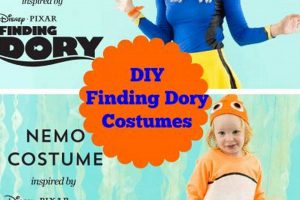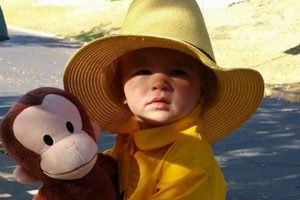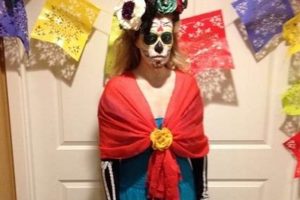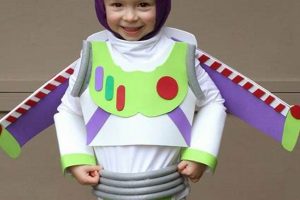Creating personalized celebratory attire for the Mardi Gras season offers an alternative to commercially produced options. This approach involves individuals crafting their own masks, outfits, and accessories, often using readily available materials and their own creative ideas. A parade attendee might, for instance, construct a feathered mask from craft store supplies or embellish a pre-owned garment with sequins and beads.
The practice of making one’s own festive clothing encourages resourcefulness and self-expression. It can be more economical than purchasing pre-made items, and it provides an opportunity to develop unique and individualized expressions of celebration. Historically, crafting ones own attire for festive occasions has been a way for individuals to participate more deeply in community celebrations, often reflecting cultural heritage and personal identity.
The following sections will explore specific techniques, material suggestions, and project ideas for generating striking and memorable celebratory looks. These instructions are designed to enable the creation of diverse and visually appealing costumes suitable for various levels of crafting experience.
Tips for Creative Celebration Garb
Successful creation of personalized Mardi Gras attire requires careful planning and execution. These tips provide guidance for those engaging in this endeavor.
Tip 1: Material Selection: Opt for lightweight and breathable fabrics to ensure comfort during extended wear, particularly in warmer climates. Durable materials like felt, canvas, or cotton blends are suitable for constructing masks and accessories that will withstand repeated use.
Tip 2: Design Conceptualization: Sketch designs and create mock-ups before commencing construction. This allows for adjustments to proportions, color schemes, and overall aesthetic, minimizing errors and material waste.
Tip 3: Secure Fastenings: Employ robust fastening methods for masks and headpieces. Elastic bands, adjustable straps, or strategically placed combs will prevent slippage and ensure a secure fit throughout the festivities.
Tip 4: Embellishment Techniques: Securely attach embellishments such as sequins, beads, and feathers using industrial-strength adhesive or reinforced stitching. Ensure that embellishments do not pose a hazard to the wearer or others.
Tip 5: Comfort Considerations: Prioritize comfort by incorporating features such as padded linings in masks, adjustable waistbands in garments, and breathable linings in gloves or gauntlets. Consider ergonomic design principles to minimize strain during extended periods of activity.
Tip 6: Color Coordination: Adhere to the traditional Mardi Gras color palette of purple (justice), green (faith), and gold (power). Incorporate variations and complementary hues to create visual interest and a cohesive overall design.
Tip 7: Safety Precautions: When using sharp tools or adhesives, implement appropriate safety measures, including eye protection, gloves, and adequate ventilation. Exercise caution when working with flammable materials.
By adhering to these guidelines, individuals can produce visually striking and durable celebratory garb while prioritizing comfort and safety. Meticulous planning and execution are essential for achieving optimal results.
The subsequent section will provide specific project ideas and step-by-step instructions for creating various pieces of celebratory attire.
1. Budget
The budget allocated for crafting celebratory garments directly influences the scope and complexity of the project. Financial constraints may necessitate the selection of less expensive materials, such as craft foam, felt, or repurposed textiles, instead of more elaborate options like silk, velvet, or professional-grade embellishments. Resourcefulness in sourcing materials becomes paramount when working with a restricted budget. Examples include utilizing recycled cardboard for mask construction, employing thrift store finds as base garments for embellishment, or organizing material swaps with other crafters.
Cost-effective strategies extend beyond material selection. Simplified designs that minimize intricate construction techniques or extensive embellishment can significantly reduce project expenses. For instance, a basic tunic-style garment requires less fabric and labor than a tailored, multi-layered costume. Similarly, hand-painted designs on fabric offer a budget-friendly alternative to costly custom printing. Effective budgeting requires careful planning and prioritization of design elements, focusing on maximizing visual impact while minimizing material costs. The level of skill can be a factor, as a beginner may tend to buy additional or unnecessary material because of lack of knowledge on the project.
In conclusion, budgetary limitations do not inherently preclude the creation of impactful celebratory attire. Strategic planning, resourceful material sourcing, and simplified designs offer pathways to achieving visually compelling results within defined financial parameters. Embracing cost-effective techniques fosters creativity and promotes sustainable practices. Ignoring budget considerations risks project abandonment or compromised outcomes. Prioritizing the understanding of the “budget” component is very essential.
2. Materials
The selection of materials is intrinsically linked to the success of creating celebratory garments. Material properties dictate the overall aesthetic, durability, and comfort of the finished product. For instance, the use of lightweight, breathable fabrics, such as cotton or linen, is crucial for costumes worn in warm climates, mitigating overheating and discomfort. Conversely, selecting heavier materials, such as velvet or brocade, imparts a more luxurious appearance but may be less practical in hotter weather. The choice of materials extends beyond fabric; embellishments such as beads, sequins, and feathers contribute significantly to the costume’s visual impact. Inadequate adhesion or low-quality materials will cause embellishments to detach easily, reducing the costume’s lifespan. The direct consequence of improper material selection is a decrease in both the aesthetic appeal and functional longevity of the garment.
The availability and cost of materials also play a significant role. Limited access to specialized fabrics or embellishments may necessitate creative substitutions. For example, plastic gemstones may be used in place of genuine crystals, or felt appliqus may serve as a substitute for intricate embroidery. Consider the environmental impact of material choices; opting for recycled or repurposed fabrics promotes sustainability. One example is the use of old t-shirts to make beads. Understanding the characteristics of different materials, from their drape and texture to their washability and flammability, is essential for informed decision-making. This knowled
ge base allows creators to optimize material usage, minimize waste, and ensure the safety and longevity of their celebratory creations. The use of proper tools affects the final product. A pair of good scissors can ensure clean lines.
In summary, material selection is a foundational element in the successful creation of personalized celebratory attire. Careful consideration of material properties, cost, availability, and environmental impact directly influences the final outcome. A deep understanding of materials allows for informed decisions, creative problem-solving, and the production of durable, aesthetically pleasing, and comfortable garments. Failing to address material considerations compromises the integrity and longevity of the overall project. The success of a custom celebratory garment starts from the ground up. That is, from the material choice.
3. Creativity
Creativity serves as the driving force behind the generation of personalized celebratory garments. It dictates the originality, uniqueness, and expressive power of the finished attire. The absence of creativity relegates the undertaking to mere replication, devoid of personal expression and innovation. Creativity shapes the narrative the costume tells.
- Conceptual Innovation
Conceptual innovation involves the formulation of novel themes, motifs, and design elements that distinguish a celebratory garment from conventional options. This facet encompasses the ability to envision unconventional combinations of materials, colors, and forms to create visually striking and thematically resonant pieces. An example includes reinterpreting traditional Mardi Gras iconography through a steampunk lens, resulting in a fusion of historical and futuristic aesthetics. Such innovation elevates a costume from a mere replication to a statement of individual artistic vision. Ignoring conceptual innovation yields costumes lacking a unique identity.
- Material Manipulation
Material manipulation refers to the resourceful and inventive use of available materials to achieve desired aesthetic and functional outcomes. It involves transforming commonplace items into unexpected components of the costume. A discarded plastic bottle becomes a decorative gem, or a burlap sack transforms into a mask. This demonstrates an imaginative approach to construction, diverting away from conventional techniques. Skillful material manipulation reduces costs and promotes sustainable practices by repurposing discarded resources. An alternative strategy is to manipulate material beyond its original purpose. This can include the use of old umbrellas for colorful material. The failure to explore material manipulation limits design possibilities and increases reliance on commercially produced components.
- Embellishment Techniques
Embellishment techniques encompass the diverse methods employed to adorn and enhance the visual appeal of celebratory garments. This includes but is not limited to painting, dyeing, embroidery, beading, and applique. Creativity in embellishment lies in the innovative application of these techniques to create intricate patterns, textures, and visual effects. For instance, utilizing unconventional embroidery stitches or blending various beading styles creates unique textures. Strategic embellishment amplifies the overall design concept and adds visual depth to the costume. Simple embellishments can be the highlight of the costume. Overlooking embellishment as a creative outlet can result in flat designs.
- Adaptive Problem-Solving
Adaptive problem-solving manifests as the ability to overcome unforeseen challenges during the construction process. This often arises when the initial design proves impractical or materials behave unexpectedly. Creative problem-solving involves devising alternative construction methods, modifying design elements, or substituting materials to achieve the desired outcome. For example, if a chosen fabric frays excessively, applying a fabric sealant can avoid further damage. The ability to adapt and improvise is essential for maintaining momentum and achieving a successful completion. Often, creative problem-solving is how innovation comes about. A rigid adherence to initial plans stifles innovation and may lead to project failure.
The multifaceted nature of creativity, as exemplified by conceptual innovation, material manipulation, embellishment techniques, and adaptive problem-solving, underscores its paramount importance. These elements intertwine to transform rudimentary materials into expressions of personal identity. In the context of creating celebratory garments, the creative process becomes as significant as the final product, providing the artisan with a sense of accomplishment and self-expression.
4. Construction
The successful realization of “diy mardi gras costumes” hinges critically on the construction phase. The methods employed in assembling materials and components directly determine the garment’s structural integrity, fit, and overall aesthetic appeal. A poorly constructed costume, regardless of its conceptual design or the quality of materials used, will invariably fail to achieve its intended purpose. Construction, therefore, represents the tangible manifestation of the creative vision, translating abstract ideas into a wearable, functional form. Improper stitching, inadequate seam allowances, or unstable fastenings can lead to garment failure during wear, diminishing the celebratory experience and potentially posing safety risks.
Effective construction encompasses a range of techniques, including pattern drafting or modification, precise cutting, secure stitching, and the integration of closures and reinforcements. The specific techniques employed vary depending on the complexity of the design and the properties of the materials. For example, constructing a heavily embellished mask requires a robust underlying structure, often involving layering and reinforcing materials such as buckram or felt. Similarly, creating a fitted garment necessitates accurate measurements and careful pattern adjustments to ensure a comfortable and flattering fit. Real-world examples include utilizing industrial-strength adhesive for securing embellishments that may be too heavy for standard stitching, or employing grommets and lacing to create adjustable closures for corsets or bodices. Neglecting the details of construction compromises the lifespan and effectiveness of the completed piece. An improperly constructed garment could break down after a single parade.
In summary, the construction phase is indispensable to the creation of personalized Mardi Gras attire. Precise execution, adherence to established techniques, and adaptive problem-solving are paramount for achieving a durable, aesthetically pleasing, and functional result. Addressing construction with diligence ensures that the “diy” effort results in a garment that contributes positively to the celebratory experience. In contrast, inattention to construction can undermine the entire creative process, leading to disappointment and potentially hazardous outcomes. Properly made costume can last generations.
5. Comfort
The consideration of comfort is a pivotal element in the creati
on of personalized celebratory garments. The extended periods of wear typical during Mardi Gras festivities necessitate attire that does not impede movement, cause skin irritation, or lead to overheating. A visually striking costume rendered unwearable by discomfort fails to serve its intended purpose. The selection of breathable fabrics, such as cotton or linen, for under layers can mitigate excessive perspiration. Similarly, minimizing the weight of accessories, like masks and headpieces, reduces strain on the wearer’s head and neck. A costume that prioritizes comfort enhances the wearer’s enjoyment and enables participation in the festivities without physical distress.
Practical applications of comfort-focused design include incorporating adjustable straps or closures to accommodate variations in body size and shape. Padding sharp edges or abrasive surfaces within the costume prevents skin irritation. Designing garments that allow for a full range of motion, particularly in the arms and legs, is essential for activities such as dancing and parading. A historical example demonstrates the consequences of neglecting comfort: early iterations of elaborate ball gowns often restricted movement and caused discomfort due to their weight and rigid construction. Modern approaches prioritize lightweight materials and ergonomic designs to enhance wearability. The degree of “comfort” can affect one’s energy throughout the day.
In summary, comfort is an indispensable component of successful “diy mardi gras costumes”. Prioritizing breathable materials, ergonomic designs, and adjustable features enhances the wearer’s experience and ensures that the costume serves its intended purpose without compromising physical well-being. Neglecting comfort factors leads to garments that are visually appealing but ultimately impractical for extended wear. The synthesis of aesthetic design and functional comfort represents a key challenge in the art of celebratory garment creation. Considering user preferences, comfort guarantees a better overall experience.
6. Durability
The longevity of self-made celebratory attire, specifically “diy mardi gras costumes,” is directly proportional to the materials and construction techniques employed. Inadequate durability results in costumes that are susceptible to damage during the often-vigorous activities associated with Mardi Gras celebrations, such as parades, dancing, and social gatherings. The ramifications of insufficient durability range from minor aesthetic flaws, such as detached embellishments, to catastrophic failures, rendering the costume unwearable and disrupting the wearer’s participation in the festivities. Selecting robust materials and employing reinforced construction methods are therefore essential for ensuring the costume’s ability to withstand the demands of the occasion.
Practical examples of durability considerations include the use of heavy-duty stitching to secure seams subjected to high stress, such as those in fitted bodices or elaborate skirts. The application of fabric sealant to prevent fraying along raw edges extends the lifespan of costumes constructed from delicate materials. Similarly, choosing weather-resistant fabrics and embellishments mitigates damage from exposure to rain or sunlight. Historical records of Mardi Gras celebrations reveal instances where poorly constructed costumes disintegrated mid-parade, causing embarrassment and inconvenience to the wearers. Conversely, well-made costumes have been passed down through generations, becoming treasured family heirlooms. Durability also becomes a factor in how and where an event takes place. Outdoor festivities may require the use of weather-proof material.
In conclusion, durability is a critical, yet often overlooked, component of “diy mardi gras costumes.” Prioritizing robust materials and construction techniques is essential for creating costumes that can withstand the rigors of Mardi Gras celebrations and provide years of enjoyment. Neglecting durability considerations risks the premature degradation of the costume, diminishing its value and potentially detracting from the celebratory experience. The creation of durable garments ensures that the effort invested in their design and construction yields lasting returns, fostering a sense of pride and accomplishment. A well made costume will eventually pay for itself because there is no need to buy another one.
7. Theme
In the realm of crafting personalized Mardi Gras attire, the selection of a unifying theme serves as a foundational element, guiding design choices and ensuring a cohesive aesthetic. The theme dictates the overall narrative and visual language of the costume, influencing material selection, embellishment techniques, and construction methods. The absence of a clearly defined theme results in a disjointed and visually incoherent outcome.
- Historical Reenactment
Historical reenactment themes draw inspiration from specific periods or events in history, such as the Victorian era, the Roaring Twenties, or ancient mythology. The creation of attire based on historical themes necessitates meticulous research to ensure accuracy in garment construction, material selection, and accessory design. For example, a costume portraying Marie Antoinette would require historically accurate fabrics, patterns, and embellishments, while a Roman gladiator costume demands attention to detail in armor construction and weapon design. Accurate historical representation enhances the educational and cultural value of the costume. A lack of historical accuracy diminishes the authenticity and impact of the theme.
- Fantasy and Mythology
Fantasy and mythological themes draw inspiration from folklore, legends, and fictional narratives, offering boundless opportunities for creative expression. These themes allow for the incorporation of fantastical elements, such as mythical creatures, magical powers, and otherworldly landscapes. The creation of costumes based on fantasy themes necessitates imaginative design and skillful execution to bring fictional concepts to life. For example, a dragon costume might involve intricate scale construction, realistic wing articulation, and fire-breathing effects. A fairy costume could feature delicate wings, shimmering fabrics, and ethereal embellishments. Accurate representation, despite not based on real world things, can be achieved through great craftsmanship. An over reliance on store-bought material diminishes the handmade nature of the costume.
- Pop Culture Parody
Pop culture parody themes involve the humorous reinterpretation of contemporary trends, celebrities, or media phenomena. The creation of costumes based on pop culture parodies necessitates a keen understanding of current events and a talent for satire. These costumes often incorporate exaggerated features, unconventional materials, and humorous embellishments to achieve a comedic effect. For example, a costume parodying a popular meme might involve the use of cardboard cutouts, oversized props, and witty slogans. Accurate representation can highlight current events. A failure to grasp the nuances of the source material can result in a poorly executed and unfunny parody.
- Abstract Conceptualization
Abstract conceptualization themes transcend literal representation, focusing instead on conveying emotions, ideas, or concepts through symbolic forms and unconventional materials. The creation of costumes based on abstract themes necessitat
es a high degree of artistic expression and a willingness to experiment with unconventional techniques. These costumes often incorporate unusual textures, distorted proportions, and symbolic colors to evoke a particular mood or message. An example is a costume representing the concept of “grief” might involve the use of tattered fabrics, somber colors, and asymmetrical forms. Abstract outfits, despite seeming to be random, usually carry a strong undertone. A lack of conceptual clarity leads to costumes that are visually confusing and devoid of meaning.
These thematic categories, ranging from historical reenactment to abstract conceptualization, represent a spectrum of creative possibilities for crafting personalized Mardi Gras attire. The choice of theme dictates the design direction, material selection, and construction methods, ultimately shaping the overall aesthetic and narrative of the costume. A well-defined theme provides a framework for creative expression, ensuring a cohesive and visually compelling outcome. A lack of thematic coherence results in costumes that lack impact and fail to communicate a clear message. Themes are what allows people to connect to the outfit.
Frequently Asked Questions about DIY Mardi Gras Costumes
This section addresses common inquiries and misconceptions concerning the creation of personalized attire for Mardi Gras celebrations, focusing on the practical aspects and challenges involved.
Question 1: Is prior crafting experience necessary to create effective DIY Mardi Gras costumes?
While advanced crafting skills can undoubtedly enhance the complexity and refinement of homemade attire, prior experience is not strictly required. Simple yet visually striking costumes can be created using basic techniques such as cutting, gluing, and simple sewing. Numerous online resources offer tutorials and patterns suitable for novice crafters. The level of complexity should align with the individual’s skill set to avoid frustration and ensure a satisfactory outcome.
Question 2: What are the most cost-effective materials for constructing DIY Mardi Gras costumes?
Several readily available and inexpensive materials are well-suited for crafting celebratory garments. These include felt, craft foam, burlap, repurposed fabrics, and recycled cardboard. Embellishments such as sequins, beads, and feathers can often be sourced from thrift stores or discount craft suppliers. Employing a resourceful approach to material acquisition can significantly reduce the overall cost of the project.
Question 3: How can the durability of DIY Mardi Gras costumes be maximized?
Durability is enhanced through careful material selection and robust construction techniques. Choosing sturdy fabrics, employing reinforced stitching, and securely attaching embellishments are essential for withstanding the rigors of Mardi Gras celebrations. Applying fabric sealant to prevent fraying and using weather-resistant materials further extend the costume’s lifespan.
Question 4: What safety precautions should be observed when creating DIY Mardi Gras costumes?
When working with sharp tools, adhesives, or potentially hazardous materials, it is imperative to implement appropriate safety measures. These include wearing eye protection, using gloves, ensuring adequate ventilation, and exercising caution when handling flammable substances. Avoiding the use of toxic or allergenic materials is also crucial.
Question 5: How can a visually cohesive design be achieved when creating DIY Mardi Gras costumes?
A visually cohesive design is achieved by establishing a clear theme or concept prior to commencing construction. This theme should guide the selection of materials, colors, embellishments, and overall style. Creating a sketch or mock-up of the costume can help to visualize the finished product and ensure that all elements work together harmoniously.
Question 6: What are the common pitfalls to avoid when creating DIY Mardi Gras costumes?
Common pitfalls include underestimating the time and resources required, selecting materials that are unsuitable for the intended design, neglecting comfort considerations, and failing to properly secure embellishments. Thorough planning, careful material selection, and attention to detail are essential for avoiding these pitfalls and achieving a successful outcome.
In summary, creating compelling DIY Mardi Gras costumes is achievable through careful planning, resourcefulness, and attention to detail. Prioritizing safety, durability, and visual cohesion ensures a rewarding crafting experience and a memorable celebratory appearance.
The following section will present advanced techniques for crafting intricate and unique costume elements.
diy mardi gras costumes
The preceding exploration has illuminated the multifaceted aspects of creating individualized festive attire. From budgetary constraints and material selection to the fundamental roles of creativity, construction, comfort, durability, and thematic cohesion, each element contributes significantly to the overall success of the endeavor. Attention to these details ensures that the resulting garment is not only visually appealing but also functional and enduring.
The choice to engage in this self-expressive crafting process offers an alternative to commercially produced goods. By investing time and effort into personalized creations, individuals actively participate in the Mardi Gras tradition, contributing to the vibrant tapestry of self-expression and resourcefulness. Future participants should consider these factors to maximize their investment and create truly memorable celebratory garments.


![Groovy, Baby! Austin Powers Costume DIY Guide [Easy] The DIY Hub: Creative Crafts, Repairs & Life Hacks Groovy, Baby! Austin Powers Costume DIY Guide [Easy] | The DIY Hub: Creative Crafts, Repairs & Life Hacks](https://craftingdiycenter.com/wp-content/uploads/2025/07/th-7257-300x200.jpg)




